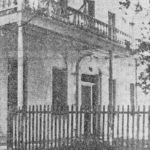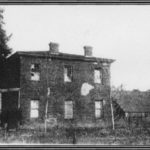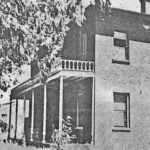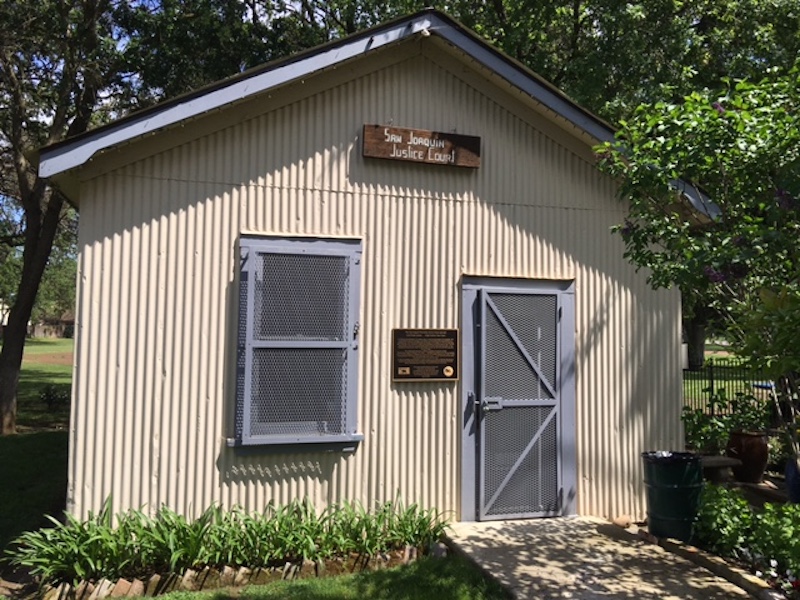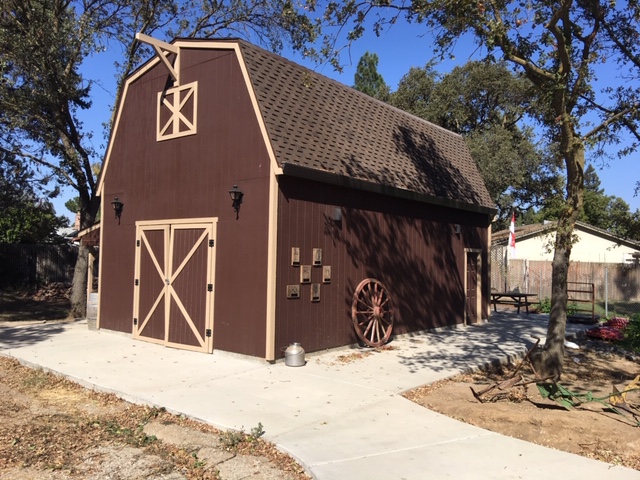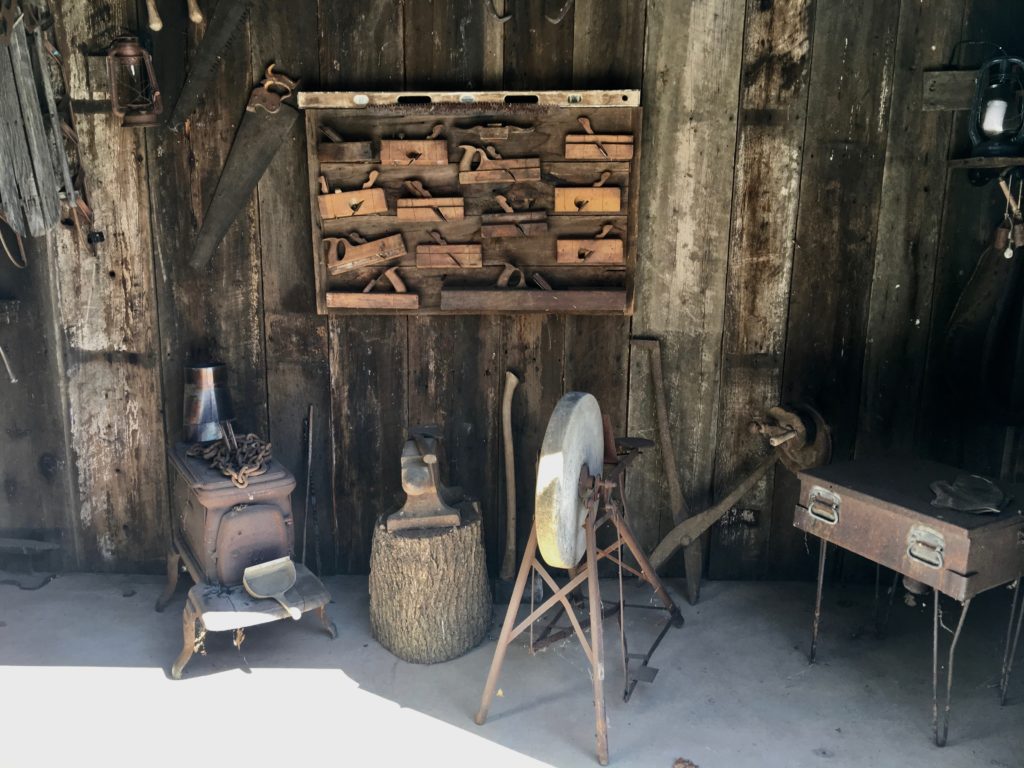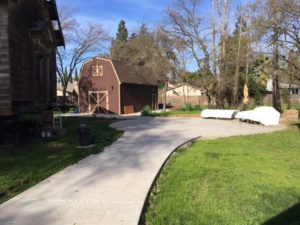Elk Grove House & Stage Stop
When Elk Grove House was torn down in the name of progress (Building Highway 99 – it was located under the north bound lane at Elk Grove Boulevard, approximately near where the present replica is located) in 1957, drawings were made and pictures taken with plans to reconstruct this symbol of our past. The hotel received historical stature in 1973. The Bicentennial Committee reorganized and formed the Elk Grove Historical Society in 1977 and reconstructed a replica of the Elk Grove Hotel and Stage Stop Museum started in 1985 and was completed in 2000. It is now the main feature in Elk Grove Heritage Park.
Taken from the April 7, 1958 Elk Grove Citizen:
“Built of solid brick in 1850, with three-bricks thick walls for the lower story, and two-brick think walls of the second story, the building was in good condition and occupied until dismantling starting. James Hall and his family came to California in the days of horse and cattle thieves and opened a hotel. (See the “James Hall Story – The beginning of Elk Grove” in HISTORY TOPICS).”
“The hotel had 13 rooms and three bathrooms and had been used as a stage stop for a short time in the early 1850’s before the Buckner Hotel was built a mile north.”
“Old timers of Elk Grove remember gunplay stories about the vicinity told to them by their parents and the story of the Buckner Hotel burning in 1857, leaving the old hotel to stand until a few weeks ago.”
“According to Mrs. Guy Foulks, who was born in the building purchased in the 1850s by her family, the Francis Grahams, the ranch included all of Elk Grove Park and land to the Cosumnes River.”
“Located on the J.M. Brown dairy ranch, the original landmark is now completely torn down. Brown said markings on the wall indicate that dances must have been held in the upper story as far back as 1882. He and son, Marion, in partnership on the ranch, plan to build two modern homes for their families from the used bricks.”
The first Elk Grove Hotel was a two-story brick building. A front door with side panels of glass led into the hallway with a staircase having a cherry rail leading to the upper floor. Rooms opened on either side, and at the end of the hallway. Both side rooms had a fireplace. The room at the end of the hallway was used as a dining room. The kitchen was a lean-to built on the east wall. The upstairs had a hall bisecting the Hotel north and south. Bedrooms faced the front side and the ballroom on the other4 side. The Hotel had a total of thirteen rooms. Bathroom and other facilities. of course, were in the back.
A large wooden porch was across the front of the Hotel and wood columns supported the balcony. An Ornate molded blister surrounded the balcony which over looked Stockton Road (later Highway 99). The upper story had French doors leading onto the balcony. The doors and windows were inset and all windows had shutters. The door casings were narrow at the top than the bottom with a decided bevel on the outer side. The Hotel had a weekly mail service, and stables were located across the road. People who loved on ranches in the surrounding area took the stage there and walked across the fields to their homes.
The Hotel served as a center in the early days with merrymakers coming from Sacramento in a tallyho, dancing all night, having breakfast, and then making a three-hour buggy ride back to the city.
James Hall left for Vallejo and the Hotel property was purchased in 1859 by the Francis Graham family, and at that time included all of the Elk Grove Park and land to the Cosumnes River. These holdings were called Graham’s Grove and Graham’s Lake. The grove became the first park district in California. Mr. Graham’s granddaughter (Mrs. Guy Foulks) was born at the Hotel.
In 1901 0r 1902 the Hotel building and surrounding acreage was purchased by Zaccheus Markofer. Fruit trees and vines were planted.
In 1916 Mr. Markofer’s younger son, Harry S., left the University of Berkley to come home to manage the ranch. When he married Florence Polhemus in April 1917, he removed the plumbing. In 1917, Mr. Markofer was called to serve in World War I and when he returned in 1919 they took up residency in the old brick house. Their first daughter, Edna Mae (Mrs. Tufts) was born there in 1920.
The Hotel and surrounding land was later purchased by J.M. Brown who had a dairy operation and orchards. In the spring of 1957, Mr. Brown and son Marion, in partnership on the ranch, had to start the removal of bricks and began tearing down the old landmark. – information from the Elk Grove Historical Society files
For many photos of the Elk Grove House & Stage Stop, go to the menu on the right and look in the “Photo Gallery.”
The Foulks House
The original home, the oldest remaining original residence in the Elk Grove area was moved to its present site, the Elk Grove Stage Stop and House Heritage Park in 2006 and has been awaiting restoration. This home was constructed in 1853 on a ranch located at Elk Grove Boulevard and Bruceville Road. Slated for demolition in 2004 it was donated to the Elk Grove Historical Society by Frank Stathos for restoration. It has been our dream to restore it back to its original 1853 condition. At the time the house was completed it consisted of three rooms; a parlor, a kitchen and dining room combination and upstairs sleeping quarters. A small lean-to addition that was added in the late 1800’s will be kept to house a small museum documenting the lives of this prominent Elk Grove Family.
Foulks Family History
We have a long detailed and extensive history of the entire six generation Foulks Family dating back to the early 1800’s, the trip out to California, and their ranch life in Elk Grove.
Without all the detail, a simple basic version is, Euphemia “Effie” Foulks lost her husband Alfred Foulks in 1847 in Ohio. Her brother Jonathan Pugh felt she had a better chance for success in California, so in 1851 she and her four remaining children headed west.
There were many trial and tribulations, but ultimately Effie received a 320 acre land grant selected by her brother in Elk Grove in 1853. They called it Oakwood Ranch because of all the oak trees. She and the children lived in the covered wagon until their house was finished in 1854. They all lived in that tiny house for many years while they built up the ranch. The first vineyard of Mission grapes in Sacramento County was established on the Foulks ranch in 1858. One son George, attended college and returned in 1881 to take over the ranch. George had a son Guy who rose to further prosperity taking over the ranch from his father and was a prominent and key public figure in the local community.
Restoration
When the house was moved to Heritage Park and placed on its new foundation in 2006, only the original structure was brought without all the added and broken down additions. Our goal is to restore the house to its original structure. This unique single wall construction that was common during the Gold Rush which no others are standing in Elk Grove or surrounding area. Upon preparing the inside for renovations we noticed that some walls had the outside paneling directly against the inside wall with out any insulation or space in between.
Because of the many fundraisers and generous donors we have raised and saved enough money for restoration and was completed. Permits and plans for a historic building are very complicated, because pre in the Summer of 2020. Present day standards didn’t exist over 150 years ago so a few modifications had to be employed.
Dedication by the historical society and plaque installed by the Native Sons of the Golden West was on December 5, 2020.
For many photos of the Foulks House, the move, and restoration, go to the menu on the right and look in the “Photo Gallery.”
San Joaquin Township Court and Jail
The Native Sons of the Golden West plaque on the front of the San Joaquin Township Justice Court and Jail reads, in part…
In 1850 the young Sacramento City needed a place to secure the bad elements of its population. The city purchased a ship, the Le Grange, to be moored on the Sacramento River and converted it to a floating prison. Cells were fabricated locally and installed. On November 18, 1859, the vessel sank and 33 prisoners in all, including two females were transferred to the Station house on land. The cells were salvaged in 1863 and 21 of its cells were placed in the new county Jail on dry land. In 1911 Sacramento constructed yet another City Hall and jail, but this time new cells were built along with a new building.
The original cells were given to different townships in Sacramento County. On September 23, 1911, Elk Grove Constable “Pinky” Brenton and his men secured two cells from the old County jail and were “made into a calaboose on the county’s lot back of the Odd Fellow building.” Further, the Elk Grove Citizen of February 3, 1912 said, “…workman in the employ of J.M. Derr are erecting an 18’ x 24’ building on a concrete base for the cells recently donated by the County.” It was used mostly for intoxicated citizens and hobo’s. The Gold Rush era cells served the community of Elk Grove until the 1940’s.
In 1983 this building was moved from its original location on 1stAvenue in Old Town Elk Grove by members of the Delta Patrol of the Sacramento Sherriff’s Department and the Elk Grove Historical Society, thus preserving an example of Gold Rush Era Justice in Elk Grove. The building stands erect in Heritage Park, completely renovated with judge’s desk and the last two surviving 4-bunk cells that remind us of an earlier time. Take a photo with the kids before you leave, it will be a great memory!!!!!
For many photos of the San Joaquin Township Court and Jail and Prison ship, go to the menu on the right and look in the “Photo Gallery.”
The Rhoads School
Even though the Rhoads School is not contained in Heritage Park it is still part of the Elk Grove Historical Society’s buildings and is located in the center of the Elk Grove Park. Here is the history…
In 1840, Jared Sheldon and William Daylor both worked at Sutter’s Fort – Sheldon as a carpenter, and Daylor tending herds. While seeking strays one evening, Daylor viewed the Cosumnes River Valley and reported back to Sheldon of its desirability and potential for settlement. Sheldon applied to the Mexican government for a land grant of over 18,000 acres and, in partnership with Daylor, established the Omuchumnes grant.
Both Daylor and Sheldon married daughters of Thomas and Elizabeth Rhoads. The Rhoads family had arrived in California in October of 1846 and their son, John Rhoads, became a member of the relief parties. He is credited with carrying Naomi Pike out of the mountains to safety on his back. While the reason for naming the school district “Rhoads” is historically uncertain, it seems most likely that it was to commemorate this heroic deed.
The first Rhoads School was built in the 1850’s by pioneer Jared Dixon Sheldon. It was close to the Cosumnes River, which was subject to flooding. Children became sick from mosquitoes bites, which we now assume was malaria, so the school closed in 1872.
In 1872 the second Rhoads School was built on Sloughhouse Road as a community effort. Its financing was by public subscriptions, cakes and pickle sales, and a benefit ball with tickets at $3.50 each. Total expenditures were $1,312.60, which included the schoolhouse, outhouse, insurance and some furnishings that were simple; desks for students, a desk and chair for the teacher, a stove, clock, broom, bucket, and dipper.
Both schools were named after John P. Rhoads, who arrived in California from Illinois in 1846.
The Rhoads wagon train traveled part of the way west with the Donner Party, though the Donners were about three weeks behind them as the Rhoads passed through Salt Lake City.
History has revealed the tragedy that met the Donner Party as they attempted to cross the mountains in what proved to be and unusual ferocious winter.
John P. Rhoads was one of seven men who volunteered for a rescue party to carry supplies to the Donner Party and bring survivors to safety. In all, he made three rescue missions.
The school opened in May 1872 with Agnes S. Jaycoax as teacher. There were 21 students enrolled, with an average daily attendance of 15. The school taught 1st through 10th grade. Ages 6 through 17 were taught and the school started out as non-graded, but when then was rated as “first grade” meaning that the teacher passed the county examination with a very high score.
All teachers were required to be at least 18 years of age and to hold a valid teaching certificate granted by the County Board of Examiners. Teacher’s salaries at Rhoads from 1872 to 1906 ranged from $55.00 to &84.80 a month, including room and board. The teacher would board with different families throughout the year. Some families were gracious and some were reluctant. Most times the teacher would walk 1-3 miles to and from school, rain or shine, carrying lunch, books and school papers.
Drinking water was carried by bucket from the well across the road at the Taylor (later the Murphy) Ranch. The bucket, with a dipper sat on a wooden bench in the cloakroom. The children drank from the dipper, and returned it to the bucket. The Taylors and the Murphy’s also allowed watering trough privileges for the horses of the children that rode to school.
Besides carrying water, students’ chores including hauling wood. The stove stood in the middle of the classroom, and was the schools only source of heat. There was no artificial light, and on very dark days, kerosene lanterns were used to add light or class was dismissed early.
The schoolyard was large, but not improved and very little play equipment and only one out house. After the first year, a second out house was built. The boy’s facility was northeast of the school – the girls was to the southwest.
Graduation exercises were usually school performances and entertainments. Usually, no more than 5 or 6 students graduated, some years none or only one. Students traveled to Sacramento to take graduation examinations to allow them to go on to high school. (Note: Elk Grove HS was built in 1893).
The 1866-1867 school year was the last time that Rhoads School District appeared in either state or county school records until 1872 when classes resumed in the newly constructed school building. It is also uncertain why the original Rhoads School closed down, but it is believed that too many children were becoming ill by exposure to “bad night air”. That is, they were contracting malaria, possible due to the school’s location in the bottomlands of the river. It was also a fact that many families were moving away. The original building burned to the ground, possibly while it was closed due to the malaria outbreak, but the timing was unclear.
In 1946 the Rhoads, Michigan Bar, Stonehouse, and Wilson Districts combined into the Cosumnes River Union School District. In 1959 the Cosumnes River Union School District became part of the Elk Grove Unified School District.
In 1976, the Bicentennial Year, the Rhoads School was moved from its home on Sloughhouse Road to the Elk Grove Park. The school was given by the Murphy family to the Sacramento County Parks Department. Members of the community contributed hundreds of hours restoring the deteriorating building and returning it to its appearance around the end of the century.
With the school in Elk Grove Park, the newly formed Elk Grove Historical Society assumed responsibility of administering it for the community.
Today the Rhoads School serves two purposes. It is a Living History Program for school classes in the Sacramento County area, and it is also a museum that is open to the public several days a year, when there are special events at the Elk Grove Park. We have expanded our open hours from 1:00 pm to 4:00 pm on the first Saturday of each month when the Elk Grove Stage Stop Museum is also open.
The Rhoads School Living History Program introduces children of today to the education life of children of the 1890’s. Third and fourth grade classes spend a day at the school, learning what it was like to be a student in a one-room schoolhouse so long ago. They come to school wearing clothing typical of what would be worn by farming children of that time.
Their subjects are the usual reading, writing, arithmetic, spelling, and also elocution and penmanship. They played the recess games that were played so many years ago. – Marbles, jacks, hoops, jump rope, and stilts.
Presently, we schedule 80 classes a school year that are taught by 6 docents. Contact us at rhoadsschool.com for information.
For many photos of the Rhoads School, go to the menu on the right and look in the “Photo Gallery.”
Blacksmith Shop & Storage Shed
The Blacksmith
by Wayne Gallup
By definition, a blacksmith is a skilled ironworker. He has the ability to make tools, horseshoes, and a variety of metal objects by heating iron in his forge and pounding it into a desired shape on his anvil. In the 1800’s many iron goods and tools were unavailable or else prohibitively expensive, so many people made their own. Farms and ranches had their own basic working facilities and most rural people could work metal with varying degrees of skill. But a blacksmith was a professional. He could show horses, treat lameness if necessary, and do any sort of skilled, custom ironwork and repairs. James Hall had a blacksmith facility at his stage stop in the early 1850’s.
Our Blacksmith Shop
Our Blacksmith Shop is by no means a local historical building. It was designed as typical early architecture to be used for needed historical society purposes. It was finished in 2018 and was created with two purpose in mind:
- We wanted a venue to show-off the many early farming items that have been donated to the museum over many years, much which are used for blacksmithing. The designated space is 20’ x 8’, plenty of room for our display. We also wanted to have blacksmith demonstrations to be done for various events and on free open tours on first Saturdays of every month. We have procured prospects.
2. Like any organization we need storage. In the past we would store supplies in the historic vacated Foulks House, but now that it is near reconstruction, there is no room for storage. The basement is now a huge research library and houses many important local artifacts and documents. At Christmas time we take over a month to convert the grounds and each room of the museum into a Christmas wonderland and have many storage containers and dozens of trees to store. We rent the facility for events and have many items and decorations to store. Also over the years many have donated their historical furniture and items for us the care for them and give them a home. We needed storage!
We now have a huge area 20′ x 30′ with a loft that allows us to take over that load. It is filled and organized and a welcome relief to our responsibility to care for our history.
An added feature is that we have been procuring local brands and charring them into small sections of wood and are mounting them on the side of the building. We just started and already have 50 brands we are working on. This was the idea of, spear headed by, and being caring out by facilities manager John Ross.
Also, adding to the ambiance and with future events planned to the area, the Dennis Buscher Plaza was constructed in 2018.
For many photos of construction and development of each part of these projects, please check out “PHOTO GALLERY” on the Menu to the right on the Home page.

